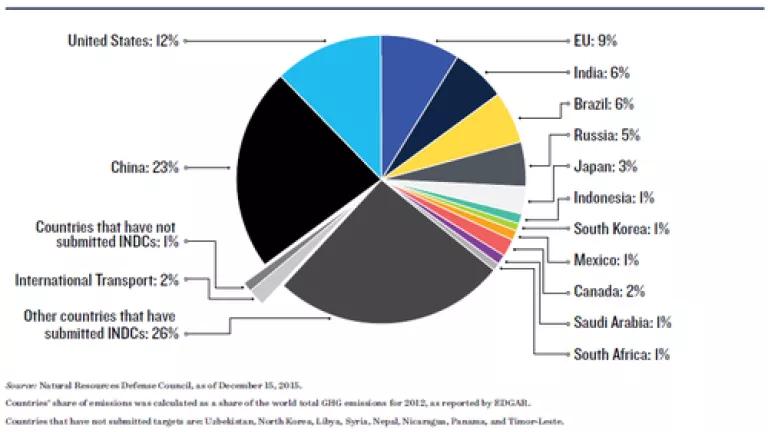
The Paris Agreement on climate change includes new climate commitments from all major countries and a system to track country-level progress towards these targets. One-hundred and eighty-seven countries responsible for around 97 percent of the world's climate pollution announced specific national emissions reduction plans for climate action after 2020 as a part of this effort. When countries formally join this agreement, starting as early as next April, they will include these emission reduction commitments in the Paris Agreement.
What national emission reduction actions did countries commit to implement?
Countries responsible for more than 80 percent of global greenhouse gas emissions made specific commitments to reduce their emissions by 2020 as a part of the Copenhagen and Cancun agreements. The Paris Agreement includes commitments that go beyond 2020. These commitments reflect a greater level of ambition than in the previous commitments. Before and during the Paris climate summit 187 countries responsible for more than 97 percent of the world's climate pollution have announced specific reduction plans (see Figure). As part of the Paris Agreement, countries will formally enshrine their climate action plans in the coming months once they formally join the agreement.
These include national climate reduction targets from all the major emitters including (see here for a complete summary):
- United States: to cut economy-wide emissions of greenhouse gas emissions by 26 to 28 percent below its 2005 level by 2025 and to make best efforts to reduce its emissions by 28 percent.
- China: peak carbon emissions no later than 2030, increase non-fossil fuels to 20 percent of the energy mix, and reduce carbon emissions per unit of gross domestic product GDP by 60 to 65 percent from 2005 levels by 2030.
- India: reduce emissions intensity by 33 to 35 percent from 2005 levels by 2030, increase cumulative electric power installed capacity from non-fossil fuel energy resources to 40 percent by 2030, and create additional carbon sequestration of 2.5 to 3 billion tons of carbon dioxide equivalent by 2030.
- Mexico (En Español): cut greenhouse gas and short-lived climate pollutants 25 percent below business-as-usual (BAU) by 2030, implying a reduction of 22 percent for greenhouse gas emissions and 51 percent for black carbon.
- European Union: reduce emissions to at least 40 percent below 1990 levels by 2030 through only domestic measures.
- Brazil: reduce economy-wide greenhouse gas emissions by 37 percent below 2005 levels by 2025, increasing renewable resources to 45 percent of the energy mix by 2030, and increasing the share of non-hydropower renewables in the electricity mix to 23 percent by 2030.
- South Korea: reduce greenhouse gas emissions by 37 percent from BAU levels by 2030 across all economic sectors.
- Indonesia: cut emissions by 29 percent by 2030 compared to its BAU level.
Paris Agreement Helps to Unleash Even Greater Action in the Years to Come
The agreement will strengthen future action by a regular process for countries to upgrade their targets since the best estimates show that these targets don't yet put us on the necessary safe climate trajectory. The agreement sets out mechanisms to ensure that these targets are the floor by creating a dynamic process for countries to adopt more aggressive commitments starting in 2020. Starting in 2018 countries will look collectively at where the current targets take us and then in 2020 there will be a political moment where countries will have an opportunity to strengthen their 2030 targets.
The Paris conference also adds to the growing groundswell of climate actions in an effort to broaden the engagement of other leaders. Governors, mayors, corporations, civil society, financial institutions, and leaders of all stripes pledged individual and collective actions that can help address climate change now.
I'm confident that countries will find it possible to strengthen their targets as they will have found that they underestimated their ability to drive a low-carbon economy that benefits their people. Further clean energy cost reductions, confidence that policies are producing larger than expected emissions reductions, and other factors will inevitably prove to leaders that they can do more before 2030 than they are prepared to detail in 2015.




